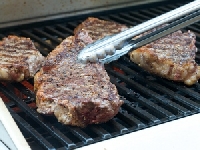
Start with what makes a steak good for grilling and you will cook a great meal
When it comes to grilling, we tend to go for the biggest and most powerful barbecue grill. This is great for your ego and your image among the neighbors, but not necessarily for the meat. In fact, when it comes to quality beef, choosing the right steaks for grilling can make you a great chef with even the smallest of grills.
The first step is to choose the right cut of steak for the grill. Ribeye is one of the best cuts for grilling because it’s tender and generally has plenty of marbling. Those thin streaks of fat in the steak are what makes it good for grilling. Trim some of the excess fat and go with the bone-in rib-eye and you have the perfect cut to cook.
A close second is the strip steak, commonly called the New York Strip. It’s a smaller piece of meat than the rib-eye but still has good marbling. Both of these cuts are affordable if you like to grill often.
Two larger cuts that come at a higher price are the T-bone and the Porter House steaks. These are actually two steaks in one, with a strip steak on one side of the bone and a tenderloin on the other, with the Porter House having a larger tenderloin. Both are reliably marbled and worth the higher price. At the other end of the price range is the top sirloin, which is not a great cut for grilling because it lacks marbling.
~
Finally, there’s the Filet Mignon. Because it’s so lean with very little fat, this top-of-the-line cut needs to be grilled quickly, so most chefs prefer to pan-sear it. No matter which cut you choose, go with a thick steak in the 1-1/4 to 1-1/2 inch range and make sure it is graded “choice,” which is restaurant quality, or “prime,” which is top shelf.
The next step is preparation. While marbling adds tenderness and juiciness to the steak, excess fat offers little extra and can cause flare-ups when it melts and drips onto the flames. Use a sharp knife to trim the fat around the edges of your steak, leaving a thin ribbon. It’s easier to cut when the meat is cold, so do it as soon as you take the steak out of the fridge.
Once the steak is out, let it sit and warm up to room temperature. At that point, salt the steak liberally, preferably with sea salt or kosher salt, and let it sit for 20 to 40 minutes longer. The salt will draw the moisture out and then the meat will draw it back in, making it more tender. The only other seasoning to add is freshly cracked or freshly ground black pepper. The coarse salt-and-pepper combination will help the steak develop a tasty crust.
Follow these steps and you have a steak that’s ready for grilling. The rest is up to you, your grill and the patience of your family and friends waiting for a juicy steak.
